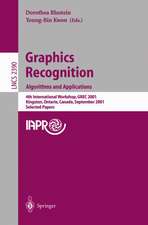Pattern Recognition: 15th Mexican Conference, MCPR 2023, Tepic, Mexico, June 21–24, 2023, Proceedings: Lecture Notes in Computer Science, cartea 13902
Editat de Ansel Yoan Rodríguez-González, Humberto Pérez-Espinosa, José Francisco Martínez-Trinidad, Jesús Ariel Carrasco-Ochoa, José Arturo Olvera-Lópezen Limba Engleză Paperback – 20 mai 2023
The 30 full papers presented in this book were carefully reviewed and selected from 61 submissions. The papers are divided into the following topical sections: pattern recognition and machine learning techniques; deep learning and neural networks; medical applications of pattern recognition; language processing and recognition; and industrial applications of pattern recognition.
Din seria Lecture Notes in Computer Science
- 20%
 Preț: 1061.55 lei
Preț: 1061.55 lei - 20%
 Preț: 307.71 lei
Preț: 307.71 lei - 20%
 Preț: 438.69 lei
Preț: 438.69 lei - 20%
 Preț: 579.30 lei
Preț: 579.30 lei -
 Preț: 410.88 lei
Preț: 410.88 lei - 17%
 Preț: 427.22 lei
Preț: 427.22 lei - 20%
 Preț: 596.46 lei
Preț: 596.46 lei - 15%
 Preț: 448.04 lei
Preț: 448.04 lei - 20%
 Preț: 353.50 lei
Preț: 353.50 lei -
 Preț: 389.49 lei
Preț: 389.49 lei - 20%
 Preț: 309.90 lei
Preț: 309.90 lei - 20%
 Preț: 645.28 lei
Preț: 645.28 lei - 20%
 Preț: 763.23 lei
Preț: 763.23 lei - 15%
 Preț: 580.46 lei
Preț: 580.46 lei - 20%
 Preț: 310.28 lei
Preț: 310.28 lei - 20%
 Preț: 655.02 lei
Preț: 655.02 lei - 20%
 Preț: 1183.14 lei
Preț: 1183.14 lei - 20%
 Preț: 340.32 lei
Preț: 340.32 lei -
 Preț: 449.57 lei
Preț: 449.57 lei - 20%
 Preț: 591.51 lei
Preț: 591.51 lei - 18%
 Preț: 938.83 lei
Preț: 938.83 lei - 20%
 Preț: 337.00 lei
Preț: 337.00 lei - 20%
 Preț: 649.50 lei
Preț: 649.50 lei - 20%
 Preț: 607.40 lei
Preț: 607.40 lei - 20%
 Preț: 1414.79 lei
Preț: 1414.79 lei - 20%
 Preț: 1024.44 lei
Preț: 1024.44 lei - 20%
 Preț: 583.40 lei
Preț: 583.40 lei - 20%
 Preț: 453.32 lei
Preț: 453.32 lei - 20%
 Preț: 575.49 lei
Preț: 575.49 lei - 20%
 Preț: 1075.26 lei
Preț: 1075.26 lei - 20%
 Preț: 585.88 lei
Preț: 585.88 lei - 20%
 Preț: 825.93 lei
Preț: 825.93 lei - 17%
 Preț: 360.20 lei
Preț: 360.20 lei - 20%
 Preț: 763.23 lei
Preț: 763.23 lei - 20%
 Preț: 340.32 lei
Preț: 340.32 lei - 20%
 Preț: 504.58 lei
Preț: 504.58 lei - 20%
 Preț: 369.13 lei
Preț: 369.13 lei - 20%
 Preț: 580.93 lei
Preț: 580.93 lei - 20%
 Preț: 343.62 lei
Preț: 343.62 lei - 20%
 Preț: 350.21 lei
Preț: 350.21 lei - 20%
 Preț: 583.40 lei
Preț: 583.40 lei - 20%
 Preț: 583.40 lei
Preț: 583.40 lei - 15%
 Preț: 438.59 lei
Preț: 438.59 lei - 20%
 Preț: 341.95 lei
Preț: 341.95 lei - 20%
 Preț: 238.01 lei
Preț: 238.01 lei - 20%
 Preț: 538.30 lei
Preț: 538.30 lei
Preț: 505.63 lei
Preț vechi: 632.04 lei
-20% Nou
Puncte Express: 758
Preț estimativ în valută:
96.78€ • 105.16$ • 81.35£
96.78€ • 105.16$ • 81.35£
Carte tipărită la comandă
Livrare economică 21 aprilie-05 mai
Preluare comenzi: 021 569.72.76
Specificații
ISBN-13: 9783031337826
ISBN-10: 3031337824
Ilustrații: XIV, 328 p. 150 illus., 104 illus. in color.
Dimensiuni: 155 x 235 mm
Greutate: 0.49 kg
Ediția:1st ed. 2023
Editura: Springer Nature Switzerland
Colecția Springer
Seria Lecture Notes in Computer Science
Locul publicării:Cham, Switzerland
ISBN-10: 3031337824
Ilustrații: XIV, 328 p. 150 illus., 104 illus. in color.
Dimensiuni: 155 x 235 mm
Greutate: 0.49 kg
Ediția:1st ed. 2023
Editura: Springer Nature Switzerland
Colecția Springer
Seria Lecture Notes in Computer Science
Locul publicării:Cham, Switzerland
Cuprins
Pattern Recognition and Machine Learning Techniques: Feature Analysis and Selection for Water Stream Modeling.- A Cloud-based (AWS) Machine Learning Solution to Predict Account Receivables in a Financial Institution.- A New Approach for Road Type Classification using Multi-Stage Graph Embedding Method.- Removing the Black-Box from Machine Learning.- Using Machine Learning to Identify Patterns in Learner-Submitted Code for the Purpose of Assessment.- Fitness Function Comparison for Unsupervised Feature Selection with Permutational-Based Dierential Evolution.- A Method for Counting Models on Cubic Boolean Formulas.- Automatic Identication of Learning Styles through Behavioral Patterns.- Comparison of Classiers in Challenge Scheme.- Deep Learning and Neural Networks: Robust Zero-Watermarking for Medical Images based on Deep Learning Feature Extraction.- Plant Stress Recognition UsingDeep Learning and 3D Reconstruction.- Segmentation and Classification Networks for Corn/Weed Detection under Excessive Field Variabilities.- Leukocyte Recognition Using a Modified AlexNet and Image to Image GAN Data Augmentation.- Spoofing Detection for Speaker Verification with Glottal Flow and 1D Pure Convolutional Networks.- Estimation of Stokes Parameters using Deep Neural Networks.- Experimental Study of the Performance of Convolutional Neural Networks Applied in Art Media Classification.- Medical Applications of Pattern Recognition: Hadamard Layer to Improve Semantic Segmentation in Medical Images.- Patterns in Genesis of Breast Cancer Tumor.- Realistic Simulation of Event-Related Potentials and their usual Noise and Interferences for Pattern Recognition.- Chest X-ray Imaging Severity Score of COVID-19 Pneumonia.- Leukocyte Detection with Novel Fully Convolutional Network and a New Dataset of Blood Smear Complete Samples.- Comparison of Deep Learning Architectures in Classification of Microcalcifications Clusters in Digital Mammograms.- Retinal Artery and Vein Segmentation using an Image-to-image Conditional Adversarial Network.- Evaluation of Heatmaps as an Explicative Method for Classifying Acute Lymphoblastic Leukemia Cells.- Language Processing and Recognition: Machine Learning Models Applied in Sign Language Recognition.- Urdu Semantic Parsing: An Improved SEMPRE Framework for Conversion of Urdu Language Web Queries to Logical forms.- Improving the Identification of Abusive Language through Careful Design of Pre-training Tasks.- Industrial Applications of Pattern Recognition: TOPSIS Method for Multiple-Criteria Decision-Making Applied to Trajectory Selection for Autonomous Driving.- Machine-learning based Estimation of the Bending Magnitude Sensed by a Fiber Optic Device.- Graph-based Semi-Supervised Learning using Riemannian Geometry Distance for Motor Imagery Classification.




























